The Best and Worst of 2022 in Documentaries
In this third and final installment of my best and worst films of 2022, I present my list of choices in the year’s documentary films. Thankfully, 2022 was an excellent year for this genre, with films covering a broad range of subjects that I watched in theaters, online and at film festivals. And, fortunately, 2022’s documentaries did not befall much of the overhyped “masterpiece” characterization attributed to some of the year’s vastly overrated narrative features.
In the interest of full disclosure, I did not see every documentary released in 2022 (who realistically could?), but I have seen nearly all of the major contenders (although there are a few I’ve yet to screen given that they have not gone into widespread release as yet). However, based on what I have watched, here are my Top 10 documentaries of 2022, followed by my list of 10 honorable mentions and a list of a few noteworthy and disappointing offerings.
Top 10 Countdown
10. “Wildcat” (USA) Web site Trailer Blog

When one is spiraling downward and hopes for the future look dim, it may seem that there’s no coming back from one’s troubles. So it was for Harry Turner, a British soldier who was traumatized by his combat experience in Afghanistan, leaving him with severe cases of depression and PTSD that nearly drove him to suicide. He felt that life was no longer worth living, so he packed up his belongings and headed to the Peruvian rainforest, hoping to lose himself there. However, once in the wilderness, he was taken with the beauty of his new environment, even landing a job rescuing orphaned wildlife with conservationist/scientist Samantha Zwicker, who eventually became his partner. Harry became particularly passionate about a program to prepare abandoned ocelots for return to the wild, a project that gave him a purpose and a new reason for living. However, despite the satisfaction it gave him, he still struggled with his mental health demons when the challenges of this effort became too great, nearly causing him and his progress to unravel. This intimate look at a complex, troubled individual, what drives him and what nearly destroyed him tugs at the heart strings in many ways, especially in its ample footage of the positively adorable felines and their intuitive bonds with their human mentor. The picture’s gorgeous cinematography and emotive score add much to this film’s heartwarming narrative, though its length is arguably somewhat excessive given the scope of the subject matter (and could have easily benefitted from some judicious editing). Nevertheless, directors Trevor Frost and Melissa Lesh have compiled an uplifting, candid chronicle of this inspiring though sometimes-painful story, one that gives hope where it’s absent and provides even the most downtrodden among us with new reasons to carry on.
9. “A Crack in the Mountain” (Hong Kong) Web site Trailer
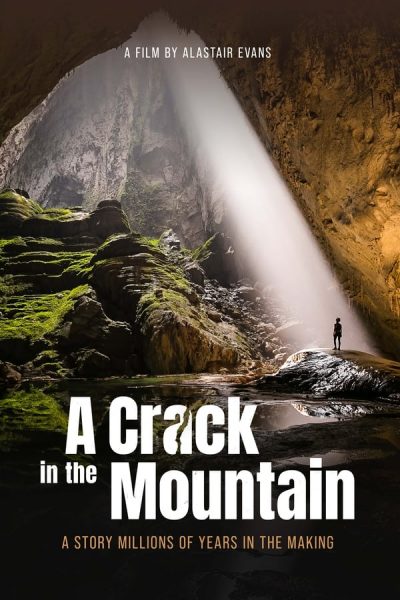
What happens when environmentalism, tourism and economic development all collide? That’s the dilemma facing the fate of the Hang Son Doong cave in central Vietnam’s Phong Nha-Ke Bang National Park, widely considered to be the world’s largest cavern system. Discovered 31 years ago and not widely explored until 2009, this four-mile-long geological formation with enormous cathedral ceilings, a fast-flowing subterranean river, an internal waterfall and pristine greenery is a UNESCO World Heritage Site and truly a global treasure. This positively gorgeous locale has an almost spiritual quality associated with it, providing visitors with a perfect environment for personal reflection and intense introspection. And, to top it all off, the cave resembles something out of a Hollywood movie a la “Avatar” (2009) or “Kong: Skull Island” (2017), a source of tremendous inspiration for many art directors and production designers in the film industry. But activists are worried whether the site will stay this way now that it’s becoming more widely known. Adventure tourists have been increasingly wanting to flock to the site, even though restrictions currently limit the number of annual visitors allowed. What’s more, investors and local residents eager to capitalize on the area’s economic opportunities have been anxious to see that potential developed. But can it be done so that ecological, business and employment considerations are harmoniously addressed, supporting sustainability and economic growth without sacrificing the environment? Writer-director Alastair Evans’s debut feature does an expert job at exploring that question from all angles, including those likely to be posed by devil’s advocates. It also provides ample discussion of the social, political, economic and historical influences that are figuring into this debate. And it’s beautifully shot and scored, showcasing Son Doong in all its splendid natural magnificence. In fact, if I had any complaint about the film, it would be that I wish it had more of that. However, what’s most important is that this documentary puts the site on the world’s radar and makes a solid case for its preservation in its authentic state, encouraging us to keep it from being overrun and tainted by the impact of hucksters out to milk it purely for financial gain. This geological gem is too important to us to lose it, so we had better protect it while we still can. And, now that the word is out, let’s hope we succeed at that.
8. “Descendant” (USA) Web site Trailer

Contrary to widely held belief, just because the US slave trade was outlawed in 1808, that didn’t end attempts to continue to import African slaves thereafter. It wasn’t until 1860, when the last slave ship, the Clotilde, entered American waters with a hold full of slaves that the practice finally came to an end. And, to conceal this crime, which was punishable by death, the perpetrators scuttled the ship by burning it upon arrival. The location of the wreckage long remained a mystery until a diving team found it in shallow water just north of Mobile, AL in 2018-19. But the discovery was more than just an archaeological curiosity; it was also significant to the descendants of the Clotilde slaves, many of whom settled in a nearby community called Africatown when they achieved freedom after the Civil War in 1865. Those living today now have actual proof of their African lineage, as well as evidence of the crime that was committed against their ancestors. Director Margaret Brown’s fourth feature outing explores this story from multiple angles in terms of its historic and personal importance, as well as from all of the fallout that stemmed from their ancestors’ experience that has carried through to this day. Given the myriad threads presented in this documentary, the focus admittedly could have been a little tighter in spots, particularly in terms of how the narrative’s many dots connect. But, that aside, the film effectively chronicles a little-known story that represents a significant benchmark in African-American history and a potential turning point in terms of how the American public at large views the question of this appalling institution and its after-effects, some of which have lingered but have gone virtually unaddressed and, arguably, even unrecognized all these years. This is a fine film that should be part of every grade school history class and a welcome addition to African-American History Month viewing.
7. “Framing Agnes” (Canada/USA) Web site Trailer

Anyone who believes that he/she has a good handle on understanding transgender culture and sensibilities is bound to have his/her eyes thrust wide open by this thoughtful, inventive documentary from writer-director Chase Joynt. In creating this offering, the filmmaker seeks to enliven the little-known life experiences of mid-20th Century transgender pioneers like the title character and how they blazed trails for those who followed, particularly in terms of their challenges related to acceptance and often having to trade one set of unfulfilling circumstances for another, in both cases as a result of society’s rigid gender role expectations. The film also addresses how these questions were often compounded by other significant considerations, especially for minorities, such as the pervasive and persistent existence of racial inequities in the days before the Civil Rights Movement, conditions that rendered these transgender individuals virtually invisible. And the picture also shows how many of those issues have lingered to this day, with change only now beginning to emerge in some regards. This is all accomplished through an intriguing juxtaposition of the observations of contemporary transgender historians and re-created actor-portrayed interviews of community pioneers by a fictional TV talk show host who’s based on UCLA sociologist Harold Garfinkel, an early researcher of this subject. Both of the foregoing elements are further intercut with interviews of the transgender performers who portray these community trailblazers, dialogues in which they provide their insights into the characters they play, as well as descriptions of events from their own life experiences. This mix of narrative components makes for an intriguing, enlightening watch, one that moves along at a refreshingly brisk pace thanks to its astute observations and economical 1:15.00 runtime. To be honest, though, as informative as the talk show sequences are (presented in a 1950-ish black-and-white format a la The Mike Wallace Interview), the use of this storytelling device feels somewhat contrived (if not more than a little precious), despite the depth of the revelations to come out of them. Still, there’s ample food for thought packed into this 2022 Sundance Film Festival award winner, much of it illuminating about both this diverse community and the notion of gender itself, regardless of one’s leanings.
6. “All That Breathes” (UK/India/USA) Web site Trailer
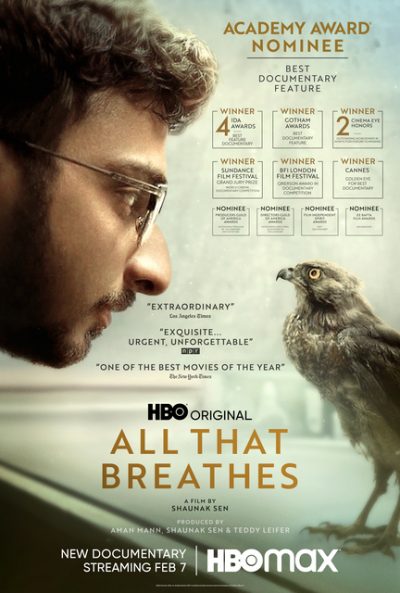
In an age where selfishness has run roughshod over selflessness, it’s comforting to know that there are those out there who have not succumbed to these troubling circumstances. Evidence of that is generously served up in director Shaunak Sen’s poetic, gorgeously filmed documentary about a pair of brothers who run a makeshift animal hospital out of their basement to heal injured birds in India’s capital, New Delhi, a city beset by choking environmental conditions and accelerating political and religious violence. The film is positively beautiful to look at and does tremendous justice to the dedication and compassion of these two wildlife Samaritans. In doing so, the filmmaker offers poignant observations about the connections that bind all of us – both man and animal – to one another, despite whatever petty squabbles or secular considerations might attempt to get in the way, augmented by thoughtful voiceovers, a beautiful, atmospheric score, and stunning cinematography, particularly in its close-up footage of the black kites that the brothers so lovingly nurture back to health. A few segments drag a bit, especially with their inclusion of too much needless incidental footage, but, if that’s the picture’s greatest failing, there’s really little to otherwise fault in this widely decorated release. This is the kind of film that beckons us to heed that age-old advice about taking time to stop and smell the proverbial roses – and to teach us all how to take flight as the truly concerted, humane individuals we’re capable of being.
5. “On the Bridge” (“Sur le pont”) (Switzerland) Web site Trailer
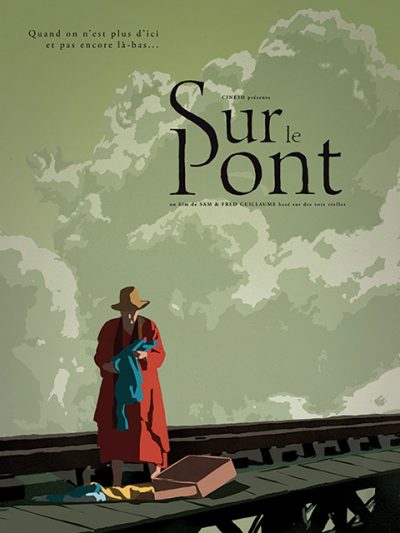
What exactly happens at the end of life? As we transition from this world to whatever comes next, what can we realistically expect? And how long does the process take – if time even means anything at that point? That’s what this insightful and fascinating animated documentary seeks to capture, combining the insights and speculation of individuals at the end of life, recorded in their own words from their homes or while in palliative care centers. Their observations span the spectrum of topics, from what they remember most about life to what they’re leaving behind to what they’re looking forward to and trying to imagine how that will unfold. Their moods range from ennui to hope to humor as they envision what’s ahead and how it will come into being. Much of this is set aboard a train where the passengers present their perceptions as it makes its way to a trestle crossing a river, the point of transition where it comes to a stop and the travelers begin the last leg of their journeys to whatever awaits them. All of this is presented through stunningly gorgeous animation backed by an ethereal score and, of course, the narrated reflections of the wayfarers making their final pilgrimages. Directors Samuel and Frédéric Guillaume have created a beautifully moving, eminently enlightening work that’s positively striking to look at. This is essential viewing for anyone who wonders what comes at the end of the line and how to properly prepare for it. If you’re not profoundly touched by this offering, I don’t know what will.
4. “Innocence” (Israel/Denmark/Iceland/Finland) Web site Trailer
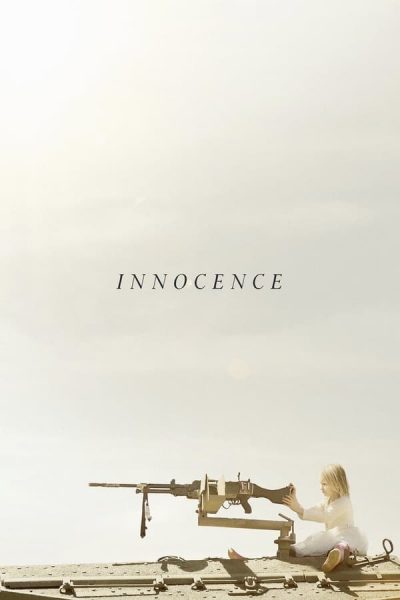
The loss of innocence – in virtually any context – is a disappointing, heart-wrenching affair. But, when such a tragedy is writ large, as it is in director Guy Davidi’s poetic but profoundly sad and quietly infuriating documentary about the Israeli government’s heavy-handed indoctrination of its youth for its compulsory military service program, that message comes through with an undeniably enraging impact. With virtually no alternate option available for conscientious objectors – of which there is a steadily growing movement among the country’s young population – 18-year-old men and women are forced into either enlisting or facing disgrace and/or imprisonment. And those who are unable to devise a suitable alternative frequently resort to desperate acts to take away the personal pain they suffer in trying to comply with their obligations but are incapable of doing so. Told through home videos and voiceover narrations of the writings of those who tried to fit in but couldn’t, intercut with footage from training exercises, government propaganda and battlefield images, the film presents a chilling portrait of an inflexible, merciless military that seeks to brainwash its youth into service, regardless of what their conscience will allow or even whether they’re fundamentally capable of carrying out the role of soldiers. As one objector poignantly observes, if the youth of the nation can’t change a system like this, who can? And, to expect otherwise is unrealistic, leading only to its perpetuation, of which youthful enablers are, unfortunately, willingly contributing to. That’s a strong statement – and one that rings true throughout this powerful release.
3. “Nothing Compares” (UK/Ireland) Web site Trailer Blog

Being ahead of one’s time can be a dual-edged sword. On the plus side, it can get you noticed. And, on the downside, it can get you noticed, but not necessarily in a positive light. Such was the experience of Irish pop star Sinéad O’Connor, who exploded on the music scene in the late 1980s and early 1990s. The musical sensation became known for one of the most distinctive set of pipes in the business, with an ability to jump octaves in a single bound and to be able to go from a soft whisper to a banshee scream at the drop of a hat. But, as director Kathryn Ferguson’s Showtime documentary illustrates, O’Connor underwent a fall from grace that unfolded almost as quickly as her stratospheric rise, a change driven by a string of unpopular public protests against the Roman Catholic Church, American and Irish government policies, and cultural practices that ran afoul of her views about militarism, abortion rights and other hot button issues. She became a pariah, unable to get airplay for her new music and even facing death threats. Her gestures were seen as acts of career suicide, none of which fazed her, given that she couldn’t in good conscience stay silent. But, as she faded into obscurity, her views gained ground, eventually leading to changes in line with those opinions. Indeed, she truly was ahead of her time, and this film examines that history in detail through archive footage, interviews with the artist and observations from those who knew her during her meteoric rise, her subsequent fall, and her resurgence as both a performer and social activist. And, as the film capably shows, in the end, nothing truly compares to her.
2. “Chernobyl: The Lost Tapes” (UK) Web site Trailer Blog
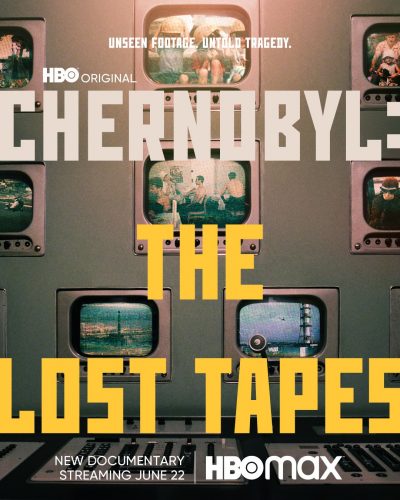
As bad as you might have thought it was, the 1986 Chernobyl nuclear power plant disaster was far worse than any of us knew, as revealed in this gripping HBO documentary from director James Jones. With a wealth of previously unseen footage recorded at the facility at the time of the catastrophe and recently taped interviews with witnesses who managed to survive the calamity, the film serves up a telling account of what happened, often in graphic horrific footage (sensitive viewers beware). The environmental damage, death toll and genetic nightmares that resulted from this tragedy are incalculable and have left a legacy that’s lasted to this day. What’s more, this release provides a detailed account of the Soviet government’s efforts to deliberately downplay the severity of the incident, including calculated deception and outright lying to its own people and concerned parties around the globe (so much for glasnost and perestroika). It’s an event that sent a powerful message to the planet about the dangers of nuclear energy and contributed significantly to the downfall of Soviet President Mikhail Gorbachev and the collapse of the USSR five years later. This should be a potent warning to us all; let’s hope we’re paying attention.
1. “Moonage Daydream” (Germany/USA) Web site Trailer Blog

Encapsulating, while simultaneously doing justice to, the life and work of a prolific and consummate artist like David Bowie is no easy feat. Sufficiently taking account of the extensive repertoire of this iconic musician/writer/painter/actor in a single film – even one that runs more than two hours – is a gargantuan undertaking just to include what Bowie did, let alone examine how and why he did it. But writer-director Brett Morgen has done just that – and succeeded brilliantly – in his latest cinematic offering, combining elements in a way that paints an insightful picture of the multifaceted artist, presenting viewers with an engaging, entertaining and introspective profile of this enigmatic and captivating talent. Morgen tells his story through Bowie’s own words, culled from numerous interviews and media appearances over the years. This material is augmented with stirring concert and music video performance footage, clips from the actor’s movie and stage appearances (including such works as “The Man Who Fell to Earth” (1976), “Just a Gigolo” (1978), “Merry Christmas Mr. Lawrence” (1983), “The Hunger” (1983) and “Labyrinth” (1986), as well as his 1980 Broadway turn in “The Elephant Man”), and an array of imagery from other artistic and cinematic sources that enhance themes prominent in Bowie’s works and the periods when they were released. The film features am impressive wealth of musical numbers, including moving performances of staples like Heroes, When You Rock ʼn Roll with Me, Space Oddity, All the Young Dudes and a heartfelt rendition of Word on a Wing (accompaniment for Bowie’s sentiments on his endearing relationship with model/actress Iman), along with several lesser-known works and impromptu collaborations with world musicians. In incorporating all this, some have criticized the picture’s length, but, when one considers just how much there is to cover, how can a filmmaker justifiably impose a shorter duration simply because the production may try the attention span of a few impatient viewers? That seems like a petty quibble in light of everything this release has to offer. That’s especially true when one realizes that this combination serves up a portrait of Bowie unlike others about him and those of other artists of his stripe, boldly setting this film apart from other biographies of this kind. It is by far the best documentary of 2022, if not one of the best films of the year. Fans and followers of Bowie are sure to enjoy, even be moved, by this offering, one that raises his artistic profile (and, one would hope, the level of appreciation he justly deserves) for the diversity and depth of his body of work, something that’s bound to become more widely recognized in the years to come.
Honorable Mentions
11. “The Jump” (“Suolis”) (Lithuania/Latvia/France/Germany/USA) Web site Trailer Blog

Taking a leap of faith – literally and figuratively – is a truly inspiring act, especially when we believe that doing so will help us fulfill a cherished dream. But what happens when that aspiration doesn’t pan out as planned? That’s what happened in 1970, when Lithuanian seaman Simas Kudirka leapt from his Soviet fishing boat onto the deck of a US Coast Guard vessel in hopes of seeking asylum, a request that was surprisingly denied, setting off both an international incident and a mass wave of indignant protests in the West. The heartbreaking and heartwarming saga he subsequently underwent provides the focus of director Giedre Zickyte’s in-depth documentary about Kudirka’s incredible odyssey. The film not only outlines Kudirka’s remarkable journey, but also presents an up-close profile of a colorful and vibrant individual, one who shows us our lack of appreciation for things that we should be valuing, as well as how to stay vital well on into our senior years. It’s a combination that works quite well, although the final segment loses some of the picture’s steam as it winds down to the final frame. Nonetheless, even though this is a story that has largely gone forgotten, it delivers a message that should never be.
12. “Jimmy in Saigon” (USA) Web site Trailer

How does one get to know about a loved one who is no longer with us and whose life no one will talk about? The profound lack of information about said individual and the unwillingness of others to share anything they know can be frustrating, if not maddening. So how is one to come to know such person? That’s the challenge that was faced by first-time feature director Peter McDowell, who wanted to know more about his deceased older brother, Jimmy, who died under somewhat mysterious circumstances in Saigon in 1972 when the filmmaker was only five years old. He knew little about his elder sibling, who was 19 years his senior, and, when he asked his family members about him, they typically said Jimmy’s passing was too painful to discuss. Peter knew that, if he truly wanted to know more, he would have to find out for himself. Thus began a decade-long project to discover the brother he barely knew, including the details of his life, his choices and his secrets. As the picture unfolds, the mysteries surrounding Jimmy gradually dissolve as the filmmaker comes closer to a series of well-concealed truths, insights that helped the director learn more about his brother, himself and the common bonds he unknowingly shared with his kindred. This heartfelt documentary thus leads viewers on a touching tale of discovery, one that painstakingly peels away layers of taboo that have long shrouded Jimmy’s story, escorting the filmmaker and audiences to heartwarming revelations that strip away the prejudices of another time, enable long-overdue healing and provide an enlightening new view of someone who was seriously misunderstood. There are times when the narrative seems to meander a bit, but, given the challenge the filmmaker was up against, it’s understandable how this might occur. However, anything worth knowing is worth waiting and working for, a truth that this younger brother ultimately comes to find out for himself.
13. “No Ordinary Campaign” (USA) Web site Trailer
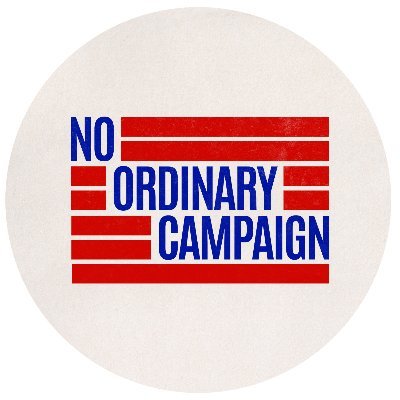
Getting the word out about a worthy cause is often an uphill battle. And, when that cause is one where those affected by it have a tremendous sense of urgency associated with it, there’s no time to lose. So it is with those afflicted with ALS, the degenerative neuromuscular illness better known as Lou Gehrig’s Disease, a condition that has historically had a 100% mortality rate, usually within two to five years. What’s more, it’s a disease whose victims have often been ignored in terms of adequate research funding, affordable caregiving options and available clinical trials, circumstances that former Assistant US Attorney Brian Wallach found unacceptable when he was diagnosed at age 37. Together with his wife, Sandra, and a band of fiercely devoted supporters, Wallach launched a broad-based campaign to change the ballgame for ALS patients, particularly in terms of eliminating the financial and government policy roadblocks that have traditionally kept them from advancing their cause within realistic time frames. Director Christopher Burke’s latest documentary feature details Wallach’s determined efforts to raise the profile of this devastating condition and to secure changes in the way it’s addressed legislatively and by government agencies like the FDA. The film’s powerfully persuasive message makes a strong, heartfelt case for support of this cause but without becoming manipulative or maudlin. It presents a detailed chronicle of Wallach’s campaign, backed by a series of interviews with ardent backers like President Barack Obama, Sen. Dick Durbin (D-IL), Rep. Mike Quigley (D-IL), and Chan Zuckerberg Foundation philanthropists Priscilla Chan and Mark Zuckerberg, as well as footage of joint ventures conducted with Team Gleason colleague and fellow ALS sufferer, former NFL star Steve Gleason, the subject of the moving documentary “Gleason” (2016). This fine offering will definitely move you, not only with a sense of compassion, but also with an unexpected sense of humor, qualities that are assured to fill viewers with a tremendous sense of hope – almost as much, in fact, as Wallach holds out for himself and those like him.
14. “Sr.” (USA) Web site Trailer
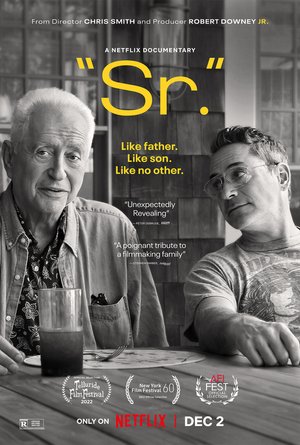
How does one sum up the life of a loved one in a few hours of film? That can be especially challenging when it involves someone who lived a full life, one that distinguished the individual in question as an artist, an innovator, a rebel, and, perhaps most of all, a loving soul. That’s the task that actor-director Robert Downey Jr. undertook when creating this cinematic tribute to his father, Robert Sr., in the waning months of his life. In doing so, the junior Downey has compiled a documentary that examines the irreverent, unconventional underground filmography of his dad, including a wealth of clips from cult classics like “Putney Swope” (1969), “Pound” (1970), “Greaser’s Palace” (1972) and “Two Tons of Turquoise to Taos Tonight” (1975), as well as footage from a project the elder filmmaker was working on during the compilation of this production. In addition, the film features interviews with some of Senior’s colleagues, such as Norman Lear, Alan Arkin and character actor Larry Wolf, along with those whose work he significantly influenced, like director Paul Thomas Anderson. But, more than that, the film also chronicles the life of Downey Sr. the man, particularly his loving relationship with his successful yet often-troubled son and his personal battle with Parkinson’s Disease. The inclusion of this material thus gives the picture a quality of universality as it seeks to address the big questions of life that we should all strive to understand as we come to the ends of our lives, issues deftly handled here with profound sensitivity and heartfelt feeling. For all these strengths, though, there are a number of sequences that feel like unfocused filler, especially early on when the film strives to find its footing and establish the tone it’s attempting to set for what follows. Once that’s accomplished, however, this offering flourishes, growing ever more captivating the further one gets into it. Indeed, there’s certainly more going on here than a mere laundry list career recitation, presenting a portrait of an individual – and a relationship – that’s far more personal than what most viewers would likely expect from fare like this. Give this one time to develop, and you’re sure to find it engaging, touching and heartwarming.
15. “McEnroe” (UK/USA) Web site Trailer Blog

Anyone interested in learning about the perils of perfectionism should check out this insightful documentary about legendary tennis star John McEnroe, the most successful player ever in men’s singles and doubles competition. As writer-director Barney Douglas’s Showtime documentary poignantly reveals, for all of McEnroe’s success, he was never satisfied with his accomplishments, a product of an upbringing in which he was perpetually pushed to be the best and came to look upon himself as a failure for anything less than perfection. Placing so much pressure on himself led to his infamous ornery streak and caused him to become known as the argumentative bad boy of the tennis world, both on the courts and in his dealings with the media. That reputation carried consequences outside the sport as well, including his hearty partying ways and troubled relations in his romantic and family life, issues that, in turn, caused his game to suffer. But those challenges eventually prompted some intense soul-searching that forced him to examine the entire spectrum of his life, both in the areas in which he had become overly obsessed and those that he regrettably neglected. Admittedly, some aspects of the storytelling are presented in somewhat overly pretentious ways, but, fortunately, these elements don’t unduly impinge on the overall narrative. But this shortcoming is made up for by the picture’s ample archival footage, as well as its telling interviews with tennis stars Billie Jean King and Björn Borg, McEnroe’s family members, and his playtime buddies, rock stars Keith Richards, Chrissie Hynde and Patty Smyth, his current wife. The result is a surprisingly in-depth look at an athlete’s life, a production that goes far beyond what many sports documentaries achieve, let alone attempt. Advantage viewers.
16. “Mama Bears” (USA) Web site Trailer

When faced with a hard choice, what is one to do? For the fundamentalist Christian mothers of LGBTQ+ children, that’s a key question when it comes to accepting or denying the truth about their kids. In many instances, the decision is often dictated by what their religious leaders say, something that’s supposed to be summarily swept under the rug quickly and easily. But, for some parents in this situation, that’s not the case, for they love their children, no matter who they may be or whatever lifestyles they have chosen to embrace. Yet, at the same time, out of fear for what their peers will say, they’re hesitant to step forward, follow their hearts and reject what they’re told to do. That’s not the case, however, for the Mama Bears, a group of courageous Christian women who have chosen to defy the dictates and do what they know is right – love and accept their kids, regardless of the consequences. Director Daresha Kyi’s superb documentary of this courageous movement follows the history of its founding, growth and activism, along with profiles of three mothers who have come to terms with their gay, lesbian and transgender children and love them just the same. This inspiring film about heroic parents conveys an uplifting message without becoming indignant, preachy or heavy-handed. Rather, it shows that love is love and deserves to be respected no matter what form it takes – and regardless what the close-minded of society may think.
17. “The First Step” (USA/France) Web site Trailer
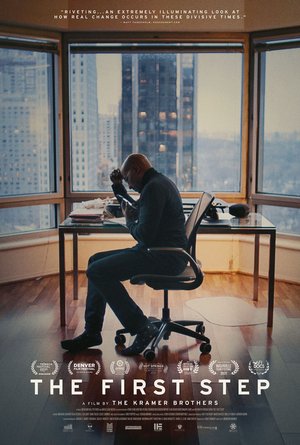
Getting things done often calls for tremendous cooperation and a degree of compromise. That’s especially true in a political context, particularly these days, where a little can sometimes get one a lot. Attorney and CNN Commentator Van Jones found that out firsthand during his efforts to help secure Congressional passage and presidential enactment of a sweeping prison reform bill during the Trump Administration, a piece of legislation – the First Step Act – that the commander in chief surprisingly supported. However, the opposition to this venture didn’t always come from the places Jones might have expected; he often faced it from constituencies that he had hoped to count on in moving the initiative forward, individuals and groups that once backed him and now even went so far as to label the life-long liberal Democrat as a sell-out and an Uncle Tom. This chiefly came about for his efforts at building bridges and consensus among disparate communities that all stood to benefit from the bill’s provisions, bringing supporters together in a spirit of purposeful collaboration. Director Brandon Kramer’s documentary about this ambitious though sometimes-controversial venture provides an in-depth look at its history, the tumultuous path Jones traversed and the inventive steps he employed in promoting its viability, as well as the personal cost to its chief advocate. The film documents how to develop a unified coalition of unlikely partners in an age of partisan polarization, a model that could readily be drawn upon to help bring about reforms in other areas at a time when gridlock has all but stalled the traditional political process. Admittedly, the material here could have been a little better organized in terms of its presentation sequence, staying a little more tightly focused and eliminating a lot of needless skipping around. However, that aside, “The First Step” delivers an important message about what’s possible when committed souls put their minds and collective efforts together to achieve a meaningful goal, something that I’m sure most of us want out of our nation’s leadership. And, in the wake of the 2022 midterm election results, it’s something that politicians had better heed and take seriously.
18. “Navalny” (USA) Web site Trailer

Uncovering evidence of scandalous political corruption can be quite a feat. Doing so when it involves those at the highest level of power can be revolutionary, making it possible to reform an existing regime. But exposing a plot by ruthless autocrats to clandestinely murder the competition in a supposedly fair election is downright appalling. Such is the case in director Daniel Roher’s damning HBO documentary chronicling the efforts of a team of intrepid investigators who surreptitiously collect evidence of a calculated assassination attempt sanctioned by Russian President Vladimir Putin against opposition candidate Alexei Navalny. When the anticorruption activist and presidential contender fell ill and nearly died from an attempted poisoning using the Novichok nerve agent, foul play by those at the highest levels of Russian politics was strongly suspected, but definitively proving it was another matter. However, while Navalny recovered in Germany, he began diligently looking into the matter with the assistance of a team of journalists and other colleagues. What they found was truly disturbing, but catching the culprits red-handed with bona fide proof was comparably astounding, setting off an international firestorm in advance of Navalny’s much anticipated, potentially dangerous return to Russia. The filmmaker captures all of this intrigue as it happens, making for a captivating watch, one that should trouble – and rouse – anyone concerned about fairness, justice and common human dignity. It’s a work that simultaneously inspires and infuriates and, regrettably, shows just how much more work we have ahead of us as a species to address fundamental issues that shouldn’t even require a second thought.
19. “Fire of Love” (USA/Canada) Web site Trailer
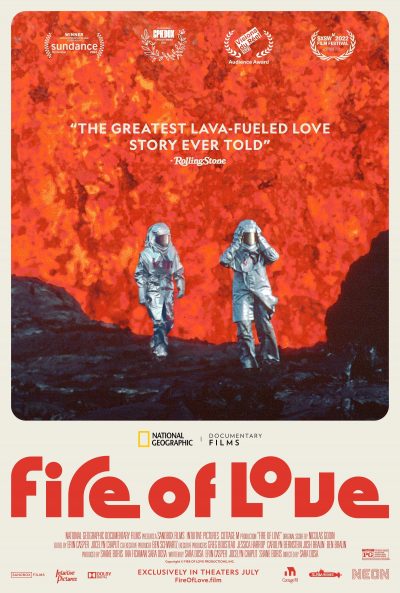
There’s no telling why two people fall in love. They may be attracted to one another’s physical attributes. Or, in some cases, they may be drawn to each other’s personalities. Or, in yet other cases, they may share passions that bind them almost as strongly as their mutual affection. In the case of Maurice and Katia Krafft, there was some of all of the above, but what really drove them as a couple was their shared interest in … vulcanology. Now, the study of volcanoes is not a particularly common interest for anyone, especially for a romantic duo, but, for this happily partnered Alsatian twosome, it was a source of commitment for their life’s work and to one another. Director Sara Dosa’s latest offering explores the unconventional lives of this quirky, unlikely pair, examining what brought and kept them together for years as they built a solid relationship while compiling an impressive body of work about their field of study. The film consists almost entirely of material from the Kraffts’ archives, including media appearances where they discussed their groundbreaking findings and a truly spectacular collection of footage from their globetrotting adventures to investigate volcanic eruptions. The filmmaker meticulously documents the courageous daring with which they approached their work, their fervor for devising safety recommendations for those living in high-risk areas, and the unexpected sense of humor and whimsy with which they often went about their field studies. This Oscar nominee for best documentary feature is indeed an interesting watch, though given the niche nature of its subject matter, it may be a little on the long side for some viewers, even with a runtime of only 1:33.00 (it ultimately may have worked better as an episode of a PBS nature series). Nevertheless, if nothing else, enjoy this one for the stunning natural beauty so vividly on display here, a show better than anything that could be produced with CGI.
20. “The Conservation Game” (USA) Web site Trailer

We’ve all no doubt seen (and likely adored) those TV talk show segments and cable programs featuring wild animals with expert handlers promoting the need to protect these magnificent and cuddly creatures, many of which are endangered and dependent on zoos and sanctuaries for safety. But, as director Michael Webber’s damning documentary reveals, those allegedly well-meaning media appearances by “ambassador animals” are a sham. Indeed, most of them are little more than a front for a clandestine network of deceit in the trade, auctioning, sale, and private ownership and exhibition of exotic wild animals, many of which make their debut on these television shows and then vanish into this murky underworld, where they receive questionable care and protection, jeopardizing their well-being and that of their owners and the public at large. This troubling investigation follows the efforts of animal welfare professional Tim Harrison into the whereabouts of disappeared ambassador animals through a series of probes into and encounters with the likes of well-known handlers and wildlife conservation spokesmen Jack Hanna, Dave Salmoni, Boone Smith and Jarod Miller, all of whom have carefully cultivated glowing reputations far different from the nature of the actions in which they routinely engage. It also follows the efforts of Harrison and colleagues to secure the passage of federal legislation prohibiting the private ownership of exotic wild animals, a campaign in which powerful opponents have fought against its enactment, even by nefarious and illegal means. The result is an eye-opening, revelatory exposé, one that will undoubtedly shatter many cherished illusions held by fans and followers of these supposed animal advocates. While some of the material in the film could have been a little better organized, especially in light of the complicated and disturbing web of deception involved, the message nevertheless comes through loud and clear, one that should positively infuriate anyone who claims to be a committed and concerned animal lover.
Noteworthy (in alphabetical order)
“All Man: The International Male Story” (USA) Web site Trailer

Who would have thought that a mailorder catalog could become a culture-changing vehicle? So it was with International Male magazine, a veiled catalog of provocative men’s clothing featuring models who epitomized the essence of virility and masculinity. From modest, seat-of-the-pants beginnings in the 1970s, founder Gene Burkard grew the publication not only as an outlet for mailorder clothing sales, but also as source of quiet but undeniable empowerment for young gay men, prompting many closeted individuals to boldly step forward as their true selves and enabling them to embolden their emerging culture. At the same time, IM’s reach extended into American culture at large, encouraging men of all backgrounds – including straight guys – to embrace clothing styles that they may have once never given a second look, making it possible for them to become comfortably fashion-conscious to a greater degree, a social shift that has persisted to this day. The widespread and often-underappreciated impact of this operation has thus been a major influence among American men in numerous ways, a phenomenon now celebrated in this fun, informative documentary from directors Bryan Darling and Jesse Finley Reed. In interviews with Burkard, many of IM’s models and staff, and a number of gay community and fashion industry insiders, along with ample clips from the pages of the catalog, viewers are treated to an in-depth look at the impact and history of the publication, as well as how it reflected and helped shape an evolving culture. There’s considerable eye candy here, too, making for an often-suggestive but eminently tasteful watch. For those interested in learning more about the reach of this influential publication, place your order now.
“Cat Daddies” (USA) Web site Trailer
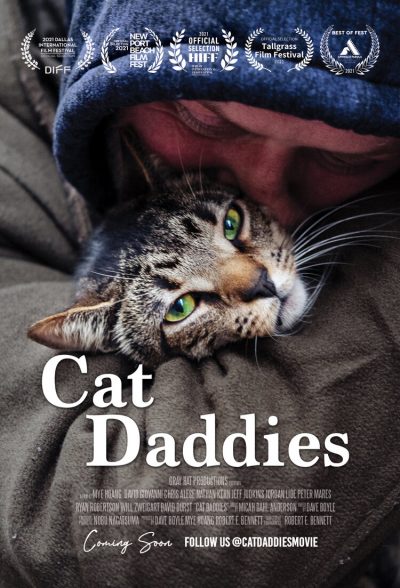
Director Mye Hoang’s adorable documentary about our furry feline friends is the kind of movie that will undeniably have viewers going “awwwwwwwwwwwww!” at least once every five minutes. This affectionate tribute to the cats of the world, as told through the stories of their adoring male owners, showcases the genuine unconditional love they reciprocally hold for one another. With tales ranging from a cat-loving actor to a truck driver who criss-crosses the country with his fuzzy four-legged companion to a homeless New York construction worker who rescued a kitten and made a friend for life, among others, the film can’t help but lift our spirits and fill us with an abundance of warmth, tenderness and goodwill. Perhaps the only fault I could find with this offering was its premise that it’s now supposedly become acceptable for big, strong, macho men to enjoy the company of their feline friends, an idea once seen as an indication of questionable masculinity. However, I find the need to express this allegedly revelatory notion as itself inherently archaic; after all, real men have been eating quiche and enjoying the companionship of cats for quite a long time now, and trying to claim that this is a “new” idea is outdated, something that could have easily been relegated to a footnote or passing reference (one need only look back to the examples set in movies like “Harry and Tonto” (1974) to see that this idea is anything but new). That aside, however, this is a delightful watch that will surely have you purring by film’s end.
“Endangered” (USA) Web site Trailer Blog

Being a journalist isn’t what it used to be. Members of this once-respected profession have been coming under increasing attack from authorities, politicians and the public, subjected to harassment, scathing insults and innuendo, unlawful detention, violent attacks, and even murder. It’s something not limited to far-flung third world dictatorships any more, either; it’s happening across America, a land in which freedom of the press is a Constitutional guarantee that’s becoming increasingly eroded by forces who don’t want to hear what reporters have to say if they disagree with their findings. The ripple effect that stems from this is that media organizations (especially newspapers) are closing their doors left and right, leaving the public with fewer and fewer watchdogs to cover what’s unfolding in a society whose institutions are becoming less trustworthy and more dubious by the day (and making opinionated streaming sites and social media outlets the new sources of record). In their HBO documentary on this subject, directors Heidi Ewing and Rachel Grady have compiled stories of journalists’ experiences from around the globe, focusing primarily on the work of professionals from Mexico, Brazil and the US. While their experiences are compelling and frontline footage from their assignments is indeed gripping, some of the material could stand to be a little better organized, and the film’s use of split screen imagery definitely should have been scaled back. However, when it comes to the picture’s examination of the coverage of high-profile events like the 2020 US presidential election, the January 6 insurrection at the US Capitol, Black Lives Matter rallies surrounding the George Floyd murder, Mexican feminist protests focused on violence against women, and the bullying of journalist Patrícia Campos Mello by Brazilian President Jair Bolsonaro for unfavorable reporting on his campaign for office, the filmmakers present an unflinching look at what journalists are increasingly up against in simply doing their jobs. “Endangered” shines a bright light on what we all stand to lose if the Fourth Estate is allowed to be further compromised by those who try to silence it and make it a mere mouthpiece for their views and a propagandist echo chamber for their supporters. As a college- trained journalist who worked in the field for years, I find it sad to see what’s become of the profession I so loved – and disheartening to witness how little most of society cares about its decline. Let’s hope we don’t live to regret that.
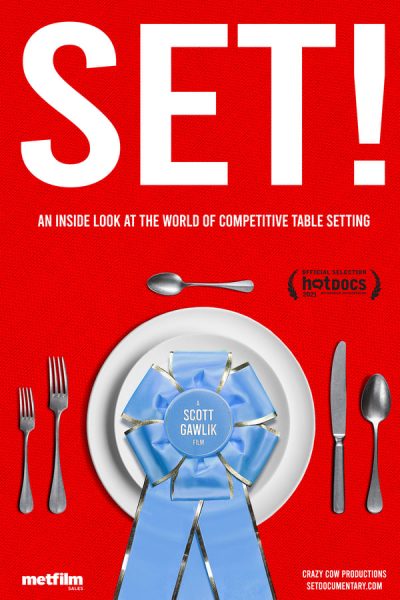
Were it not for this film, one might think its eccentric subject matter was something featured in The New Yorker or on a CBS Sunday Morning segment, if not an outright fabrication. However, director Scott Gawlik’s tongue-in-cheek documentary chronicles the polite but cut-throat world of competitive table setting as seen through the eyes of a number of entrants in California’s Orange County Fair contest. As daffy and offbeat as all of this may seem, it’s a deadly serious undertaking for this determined band of wannabe Martha Stewarts, who’ll generally go to great lengths in terms of time, money and effort to take home their prized ribbons. In telling the individual stories of these contestants, the film explores the diverse outlooks with which they approach the competition, as well as their various personal motivations for participating in something many of us might find trivial, inconsequential and fraught with nitpicking rules of what’s considered proper table etiquette. However, when viewers see the artistry involved in these settings, as well as the pride their creators take in their design and assembly, it’s apparent this is an art form all its own, if a bit esoteric and quirky and, at times, astonishingly thought-provoking. Like the table presentations themselves, the film showcases its material in meticulous detail, perhaps even more so than what many viewers may want to know, making for an offering that arguably goes on a little longer than expected or desired. But this offering nevertheless introduces us to a world many of us have probably never seen or even been aware of, and it does so with a delightfully cheeky, wry sense of humor and ample place setting eye candy. Bon appétit!
Disappointing
6. “Loudmouth” (USA) Web site Trailer
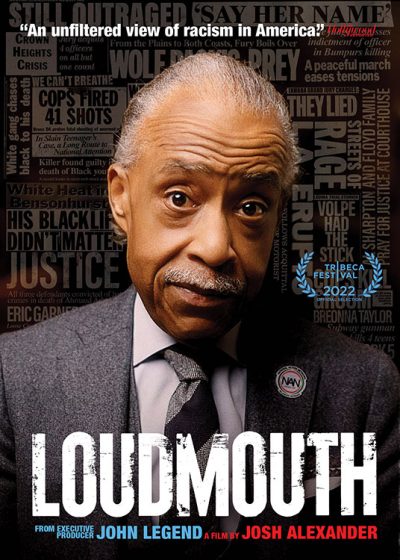
Rev. Al Sharpton is one of those figures who people either love or hate. Some say he’s a passionate advocate for civil rights, while others contend that he’s a self-promoting opportunist who’s “in the civil rights business.” Regardless of what one thinks, though, there’s general consensus that he’s an undeniably outspoken force, one whose candid character and personality live up to every bit of this documentary’s title. Director Josh Alexander’s profile of this often-polarizing presence seeks to present a definitive look at Sharpton’s life and work, but, unfortunately, it misses the mark in several respects. To begin with, the material is poorly organized, jumping around without a well-defined sense of direction and weighed down by an excess of narrative minutiae and incidental archive footage. (There’s quite an irony in that, too, given that Sharpton contends in one of the film’s monologues that discussions of minority concerns are often muddled in the media, a problem itself echoed in the content of this offering, much of that attributable to those aforementioned shortcomings.) Moreover, there’s not much in the way of a backstory here, providing viewers with little meaningful insight into Sharpton the individual, his motivations, the influences that drive him and his life outside the public eye, elements that undoubtedly play an important role but that ultimately receive little more than passing attention. Consequently, by not digging deeper, the picture comes across largely as a somewhat overlong checklist of career accomplishments and a diluted examination of the significant messages for which its principal supposedly stands. Also, without a more scrutinous analysis of the concerns of the protagonist’s critics, and with the regular inclusion of what could be seen as self-congratulatory monologues, the film tends to lean toward being a work of deftly spun, well-polished adulation. That’s not to suggest such admiration is undeserved, but, given the often-divisive nature of this highly visible public figure, its arguably one-sided presentation in this regard feels somewhat unbalanced. “Loudmouth” could have indeed been a compelling look at an iconic individual, but it instead comes across as a tribute that’s more concerned with being respectfully reverential and not offending than with providing meaningful, sincere enlightenment.
5. “Gemmel and Tim” (USA) Web site Trailer
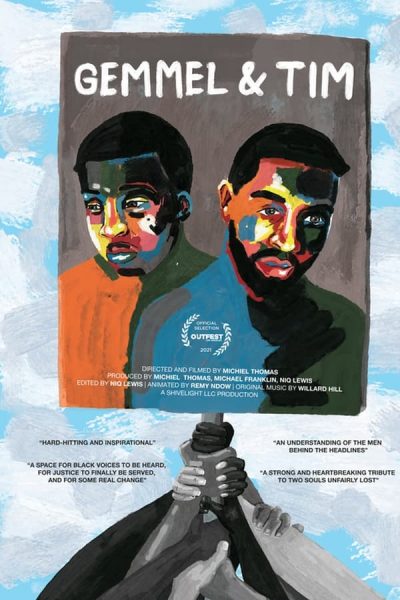
Delving into the murky waters of a criminal investigation can be tricky business. So it was in the questionable deaths of two gay Black men, Gemmel Moore and Timothy Dean, in less than two years in the West Hollywood home of well-connected Democratic Party donor Ed Buck. Both men succumbed to drug overdoses that were officially labeled accidental, but were they really? Given Buck’s reputation for hiring escorts for engaging in various drug-related sexual fetishes, it was widely believed that his actions may have contributed to the deaths of the two men. But was it negligence that led to their passing, or was it murder? That’s what director Michiel Thomas’s documentary attempts to uncover. Through interviews with those who knew Gemmel and Tim, as well as a wealth of archive news footage of the story as it unfolded, the film seeks to piece the tragedy together. It’s on this point, however, where the film muddies the waters somewhat. While the picture paints an unfettered, heartfelt portrait of the feelings of the victims’ devastated survivors, it’s not always as clear as it probably could have been when it comes to spelling out exactly what Buck might be guilty of. The film often conveys impressions that are more in line with emotions than with the particulars of the case, and it’s careful not to misstate matters. But that effort frequently becomes lost in the shouting and misery, leaving viewers, at the very least, modestly confused by the actual specifics of the story. It’s a truly sad tale, to be sure, and what happened was indeed tragic, and, on that point, the film succeeds brilliantly in conveying the pain associated with these circumstances. It’s just unfortunate that it didn’t carry through as well as it could have on the other aspects of this heartbreaking misfortune.
4. “Riotsville, U.S.A.” (USA) Web site Trailer
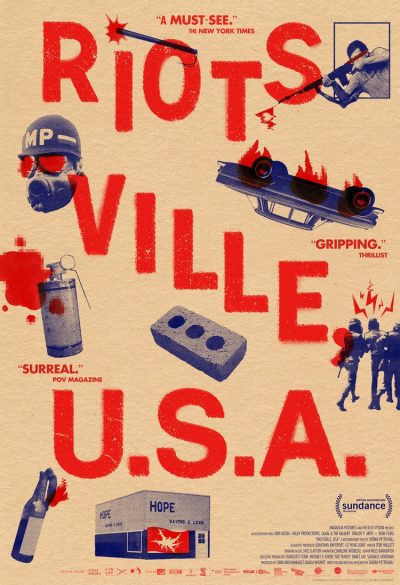
It’s unfortunate when a film has an important message to convey but does a poor job of saying what it has to say. That’s the problem with this documentary about the policies and practices underlying government efforts to control violent civil disobedience in major US cities during the mid to late 1960s. It focuses on the training programs employed at US Army bases where model cities (called “Riotsville”) were built to stage simulated disturbances used for instructing military and police forces on how to quell such outbreaks in line with official government policies. But the film goes beyond that, trying to explain why these incidents were occurring with increasing frequency at the time and why such extensive training measures had become necessary. In doing so, the picture examines the frustrations associated with, and subsequent reactions to, the issues of poverty, racism, police brutality, inequality and the impact of the Vietnam War, among others, principally in minority inner city communities. It tells this story using only archive footage from the time, drawn from television broadcasts and official US military training films. However, given the broad scope of this story, director Sierra Pettengill’s third feature outing doesn’t delve nearly deep enough into these issues, somewhat surprising given the wealth of material at the filmmaker’s disposal. Nor does it tie the Riotsville project to these larger questions as well as it could have, relying more on implication than connection. Moreover, this shallow, underdeveloped approach is further undercut by a number of poorly chosen video segments and others in desperate need of editing out extraneous content. Add to that far too many explanatory subtitles and a number of dull, overwritten voiceovers seeking to philosophically elaborate on its conclusions, and you’ve got a watered down presentation of material deserving to be delivered with a greater sense of hard-hitting candor and urgency. This is the sort of film that should make audiences angry, not put them to sleep, but this offering does more to promote the latter than the former. This is a story that would have been better told through more skillful directorial hands for it to have the impact it requires. Unfortunately, that’s not the case here.
3. “Manscaping” (USA) Web site Trailer

As men have become more conscious of their appearance, that trend has extended beyond clothing to their grooming rituals, especially in the LGBTQ+ community. In the pursuit of creating distinctive looks for themselves – including everything from hair styles to skin care to the preening of their most personal regions – they have increasingly sought out the services of skilled tonsorial and cosmetological experts who practice the art of manscaping. It’s a field that has grown ever more specialized in recent years, too, with practitioners who offer unique and customized services to their clients. From that, one might think that these services would provide ample fodder for documentation and discussion. Unfortunately, director Broderick Fox’s latest documentary woefully misses the mark when it comes to this subject. This scant 60-minute release is essentially limited to the work of two manscaping professionals and an artist whose works celebrate the barbering arts (why he was included here truly escapes me). What’s more, these subjects represent some of the more extreme examples of what manscaping is all about, excluding the work of more typical practitioners and portraying this art as a fringe activity. In doing this, the director leaves considerable material on the table and presents a somewhat skewed perspective on this topic. The film also annoyingly goes off topic often, exploring subject matter that’s only tangentially related to the supposed main thrust of the picture. Sadly, this offering represents a missed opportunity, leaving viewers with an underdeveloped look at something that should have been a source of fun, diversity and insight.
2. “North by Current” (USA) Web site Trailer

It’s indeed gratifying when a documentary attempts to takes an unconventional approach in telling its story, presenting a work of nonfiction in an unexpected way. That’s particularly true for offerings that have highly personal components associated with them. However, to pull off such a result, the director of such an undertaking must have a clear vision to make things work, something that’s decidedly missing in this title created for the PBS series POV. Transgender male filmmaker Angelo Madsen Minax’s account of his dysfunctional Mormon family in a small western Michigan town spans five years, documenting events coming in the wake of the death of his two-year-old niece under mysterious circumstances. It’s a tragedy that brought a number of troubling issues to light – some legitimate, others falsely hatched out of sloppy investigative work, but all of which led to an array of painful outcomes. In telling this story, though, the filmmaker seeks answers that aren’t readily forthcoming, his attempt at making sense out of things coming up short, and that’s clearly apparent in the finished product, one that often makes little sense of its own. The attempted fusion of straightforward storytelling with poetic observations, home movie clips from his upbringing, arthouse cinematography and lofty philosophical musings simply doesn’t work. The picture often feels like it’s reaching to make a statement that it’s unable to define for itself, leaving viewers more puzzled than enlightened. This experiment is certainly commendable for its artistic audacity, but the result is frequently inscrutable. As a nominee for the 2021 Independent Spirit Awards’ Truer Than Fiction prize, it’s apparent that the director possesses a singularly distinctive perspective, but he obviously needs to clarify it in a more accessible way in future projects to engage audiences rather than frustrate them.
1. “Brainwashed: Sex-Camera-Power” (USA) Web site Trailer

The objectification of women is certainly a crucial issue that needs to be dealt with. However, if awareness of the problem is to be raised, it definitely requires a better film than this specious, sloppy, cherry-picked offering. Based on a TED Talk-style presentation titled “Sex and Power: The Visual Language of Film” by director Nina Menkes, the filmmaker makes the argument that objectification is a result of the way male-female interactions are typically staged in movies, a practice that reflects a phenomenon referred to as “the male gaze,” a leering stare that, in turn, is allegedly responsible for things like employment discrimination in the entertainment industry and increased incidents of sexual harassment and assault. And, because films “reinforce” this practice, as Menkes insists, they’re at fault for these troubling problems, consequences that are a direct result of the decisions made in the male-dominated movie industry. One might say, based on these contentions, that this is indeed a plausible hypothesis given the proliferation of these filming techniques in motion pictures. There’s just one problem with this theory – it’s largely preposterous. To begin with, “the male gaze” has been around a lot longer than the movie business (like, say, all the way back to prehistoric times), a notion implied just by the very idea that movies are said to “reinforce” this practice, suggesting its earlier appearance in the history of the species. Second, males invoke the gaze with more than just women (just ask almost any gay man who’s checking out another male at a bar or community event). And, third, this practice is engaged in by men who never go to the cinema (especially many of the somewhat obscure titles the director cites as examples to allegedly prove her point). The argument is further undermined by some of the film clips she uses in a failed attempt to add credence to her contention – pictures that were directed by women that incorporate some of the same filming techniques she so pointedly criticizes. She even takes issue with the staging of a scene in the film “Bombshell” (2019), a picture whose very intent is chronicling the appalling sexual harassment scandal at FOX News involving power broker Roger Ailes, lambasting it for employing some of the same filming practices that this production was seeking to expose while supposedly overshadowing its central message. Of course, to demonstrate how things should be done, Menkes taps a number of clips from her own movies (titles that I, as an avid cinephile, have never heard of and that include content similar to what she’s criticizing, even if filmed somewhat differently). (Ah, yes, nothing like a little blatantly shameless self-promotion to help prove one’s point.) To its credit, this documentary draws worthy attention to the issues of objectification, employment discrimination in Hollywood and sexual abuse, but this film is a sorry representative of those issues, all of which are addressed much more effectively by releases like “This Changes Everything” (2018) and “She Said” (2022). Those other films are much more interesting than this snooze, too, a clunky offering that plays more like a doctoral seminar than a documentary film. It’s truly ironic that Menkes asserts men have become brainwashed into this way of thinking by what they see in the movies, when, in fact, it’s a longstanding behavioral tendency (propriety notwithstanding). Indeed, it seems that the only one who has been brainwashed here is the director herself — and by her own material.
Copyright © 2022-2023, by Brent Marchant. All rights reserved.



